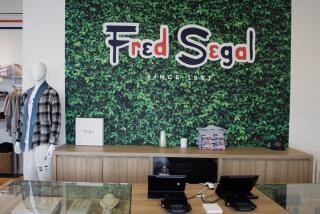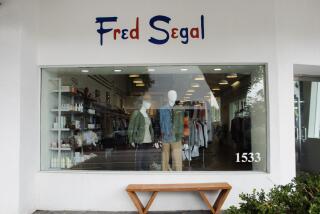Levi Strauss Says Demand for Blue Jeans Is Up Again
- Share via
NEW YORK — Levi Strauss & Co., which last year was forced to close 14 factories in the United States and eight overseas because of a sharp decline in sales of blue jeans, has begun to see a significant resurgence in demand for its major product.
“Our downtrend has reversed,” Thomas W. Tusher, executive vice president and chief operating officer of the San Francisco-based company, said in an interview Thursday after a talk to securities analysts here. “We are seeing a return from fashion jeans to basic jeans. We expect to see our jeans business continue to grow.”
Last year, customers’ preference for trendier designs caused sales of Levi’s basic 501 jeans to fall sharply. The executive said research has not yet indicated whether the upturn in demand for the basic Levi’s means that the market is growing or that the company is taking market share from competitors.
Tusher said, however, that, despite the upturn in jeans sales, the company’s sales for the second quarter of 1985 will be “modestly below” those for the same period last year and that sales for all of 1985 will be flat or modestly higher. Sales last year fell 8% to $2.51 billion because of costs associated with discontinuing several product lines, including accessories, rainwear and Olympic clothing, Tusher said. Profits, meanwhile, fell 79% to $41.4 million from $194.5 million in the year before.
Earnings, however, which were up 23.6% in the first quarter of 1985 to $13.6 million, will be up by a greater percentage for both the second quarter and the full year, Tusher said. He cited as reasons for the improvement “the full impact of last year’s cost reductions” and plant closings. This year, he added, “all our plants will be working on overtime, and we’ll have profit-margin improvement.”
Robert D. Haas, Levi Strauss’ president and chief executive and a grandnephew of the company’s founder, told the analysts that the company is now operating at “quite reasonable (capacity) rates, including some overtime in the United States.”
“We are constantly reviewing production needs in view of shifting market demands . . . yet occasionally we will be on allocation,” he said. The company has recently started rationing units in some lines that it sends to retailers.
Last year, in an effort to renew interest in its basic 501 jeans, the company spent $36 million on advertising. This year it plans to spend $20 million promoting the product, Tusher said. The 501 jeans, direct descendants of the overalls designed by the company’s founder in 1850, are the company’s highest-volume product in both units and revenue.
More to Read
Inside the business of entertainment
The Wide Shot brings you news, analysis and insights on everything from streaming wars to production — and what it all means for the future.
You may occasionally receive promotional content from the Los Angeles Times.










